Nonsense or silly words are a big thing in early education these days, and practitioners are looking for more ways to teach them successfully. If this sounds like you, then you have come to the right place. I have been attempting to teach nonsense words for ten years, and in this post I condense all that hard-earned knowledge into one definitive place.
How do you teach nonsense words? Nonsense words can be taught through a range of adult-led and more independent games. Begin by using just a few sounds that the children know very well. Experiment with strange combinations, and sound out these words.
Teaching nonsense words can be a bit stressful if done at the wrong time, and done in an uninspiring way. Luckily this guide will come to your rescue.
I’m going to start by looking at why we teach nonsense words and when to teach them. Then we’ll dive into lots of fun ways of teaching them that get children inspired and engaged.
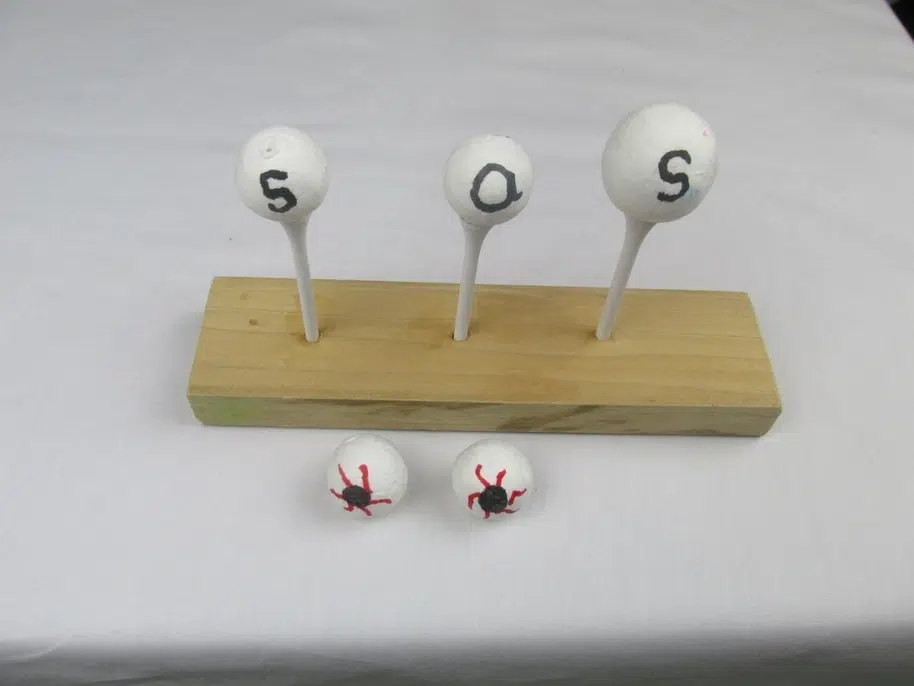
Why Teach Nonsense Words?
There is lots of research that the teaching of nonsense words helps with progress in phonics.
In a nutshell, when you read a short nonsense word, you are reading a syllable. These syllables, although they may not mean anything by themselves, will often feature in longer words. Therefore, you will have more chance of reading longer words successfully if you are used to reading these smaller chunks.
When To Teach Them
I would say definitely teach reading real words first. Only go on to reading nonsense or silly words when children are OK at reading at least a few real words.
Also, I would only start with sounds that the children know really well. Even if they know maybe about twenty sounds, I would start the nonsense words with the first ten or so that they know.
The more confidence they have in the sounds, the more confidently they will begin to read the nonsense words.
I would start with words made out of s, a, t, p, I, n, m, d and o. For example, ‘dap’, ‘pid’, ‘nid’, and ‘nop’.
Expand your range of sounds when they become confident with these.
Nonsense Words Shouldn’t Be A Priority
Real words should always come first! Nonsense words should just enhance their experience of phonics, and give them some extra skills that are great later on in the process.
Right then, let’s have a look at some exciting ways of brining the teaching of nonsense words to life!
1.Using A Phoneme Frame
Phoneme frames are one of the best ways to get children beginning to read words when they start.
A phoneme frame is simply a grid with three boxes. The grid you can put sounds to create words. It is a great structured way to get children understanding how to build words. If you would like to find out everything about what a phoneme frame is and many imaginative ways to use them then check out this article I wrote.
There are so many ways to make them! For example, you can use an egg box with three sections. You can draw a phoneme frame on the ground with chalk. They can be drawn on whiteboards, or on logs.
One of the favorite phoneme frames that I have used are the log phoneme frames.
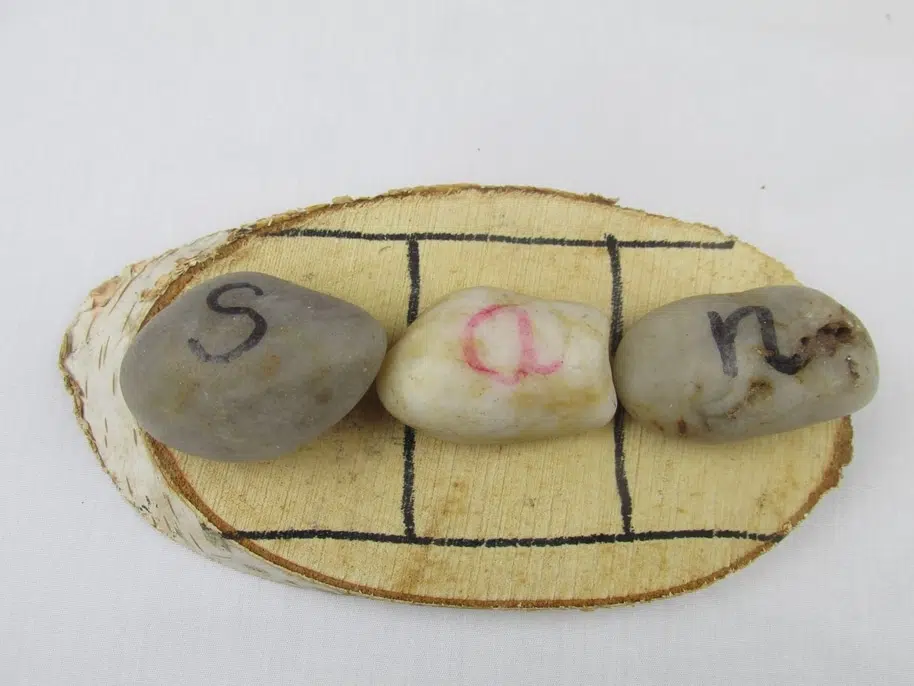
I found some log slices in a hardware shop. Using a permanent marker pen I drew lines onto the log to create a phoneme frame. I have a set of 8 logs. On one side they have a three-box phoneme frame, and on the other they have a two-box.
I use stones with sounds on to go with them. The stones have consonants written in black, and vowels written in red. You teach the children that if you go ‘black, red, black’ then you always get a word that you can sound out, whether it is real or silly.
It is a great natural resource, and it is good for them to experiment. Often the best ways of teaching nonsense words involve reading both real and silly words combined.
2. Using Phonic Dice
This is another beautiful natural resource. These started life as a fence post that I sawed into cubes.
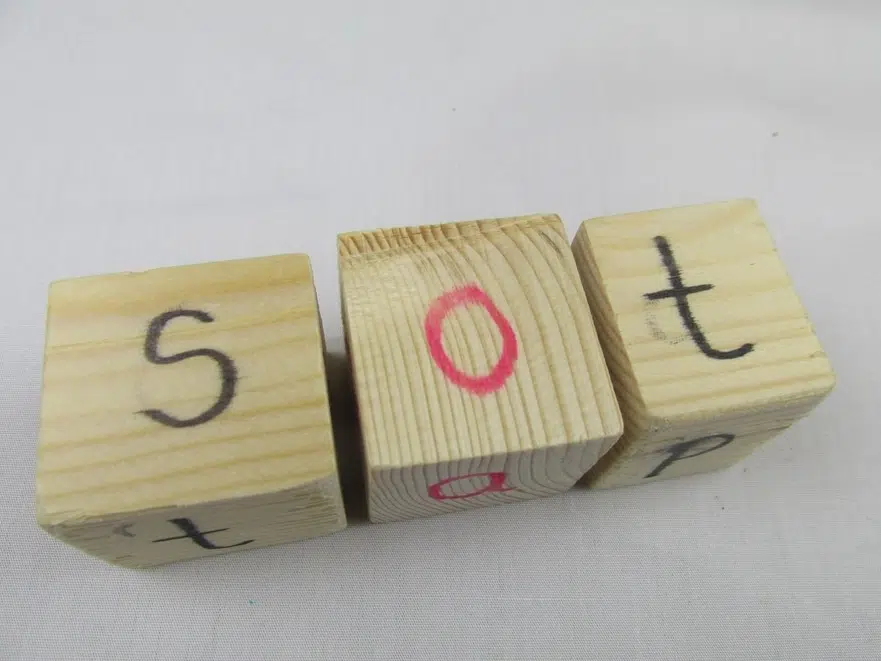
All you need to do is sand the edges down a bit, just so no-one gets a splinter.
All you need is three dice to be able to play the game. If you have no wood, or don’t fancy sawing any, then other big dice will work well. For example, you can get the dice with the big transparent pockets in that are great for this activity.
The idea is to have two dice for consonants, and one dice for vowels. Again, I would color code them. The dice I use have black consonants, and red vowels.
Take turns to roll the dice! See what words you make.
I coach the children to put the dice in the order – black, red, black. Then you always get a word that you can sound out, whether it is real or silly.
3. Making Sounds On Bolts And Cogs
This one is great for fine motor, and just generally fantastic for children that like fiddling with things.
You just need a few big bolts with cogs on for this – I’d say the bigger the better. You need at least three cogs.
Then, using a permanent marker pen, you write sounds on the cogs. Again, I would have two consonant cogs and a vowel cog.
Then you screw the cogs onto the bolt so that it goes consonant, vowel, consonant.
As a general tip, you may want to attach something to end to stop the cogs coming off. A good idea might be a some tape. Or you could probably superglue another cog to the top. You can also buy small caps that again can be superglued to the top.
This just stops young children taking them off, and either losing them or eating them.
The idea, when you have made it, is to twizz the cogs around and see if you can make a word! Again it will be real or nonsense. Make one and try and sound it out. Try to decide if it is real or nonsense.
4. Making Aliens!
So many children respond really positively to space and aliens, so it is great theme to introduce into phonics to get them inspired.
This is also a really simple and cheap activity to set up. All you need is either some plasticine or playdough, and some craft sticks.
Get a lump of dough. This is the alien’s head.
Then write some letters on the craft sticks. Once again I like to color code – black for the consonants and red for the vowels (or some other color scheme of your choice).
The idea now is to get the children to make aliens! The aliens will always have three eyes. You stick the craft sticks into the alien head, and you will have an alien with three phonic eyes.
The eyes always go black, red, black. Then you will have a real or nonsense word to sound out.
With this activity, you could have a list of ‘alien names’ that you could make.
This will give the children the chance to match the sounds and build words. Then they can try and sound them out.
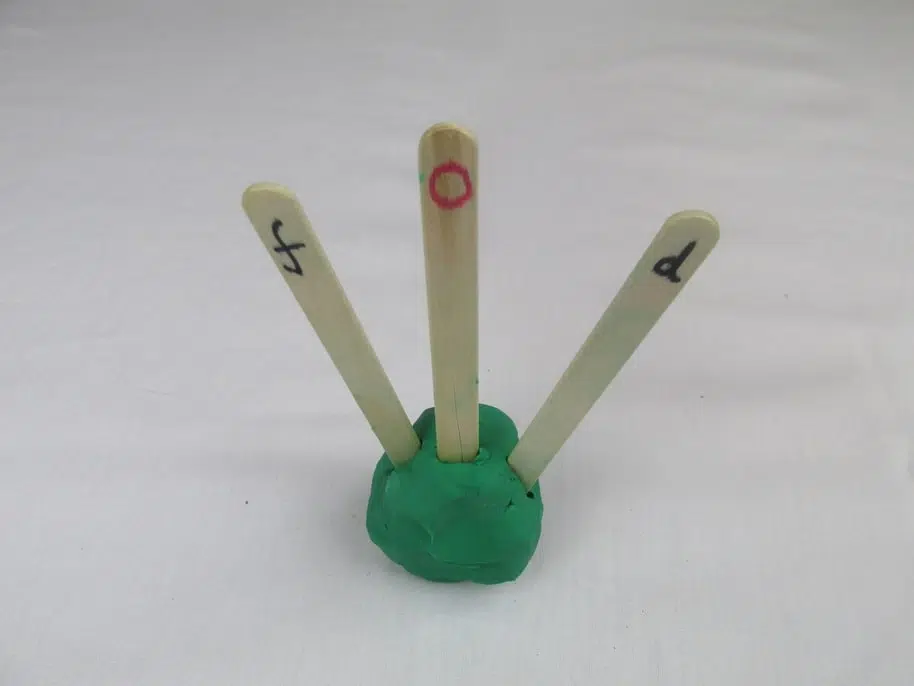
Simple games using resources such as playdough and sticks can often be some of the most exciting you can do! To find out many more simple games like this one, check out these 15 brilliant playdough maths activities.
5. On A Washing Line
Washing lines are one of the very best ways of teaching phonics. They are really engaging, and they are both visual and hands-on, which is a great combination. To read my in-depth guide about using washing lines for phonics then click here.
You can peg sounds on, or even easier is to use little pieces of card that are bent over. These are great for children with fine motor issues, as you don’t want the fine motor element to be the main focus here.
Again I color code the consonants and vowels. The ones I have got are orange for consonants, and yellow for vowels. If you go orange, yellow, orange, you always make a word that you can sound out whether it is real or silly.
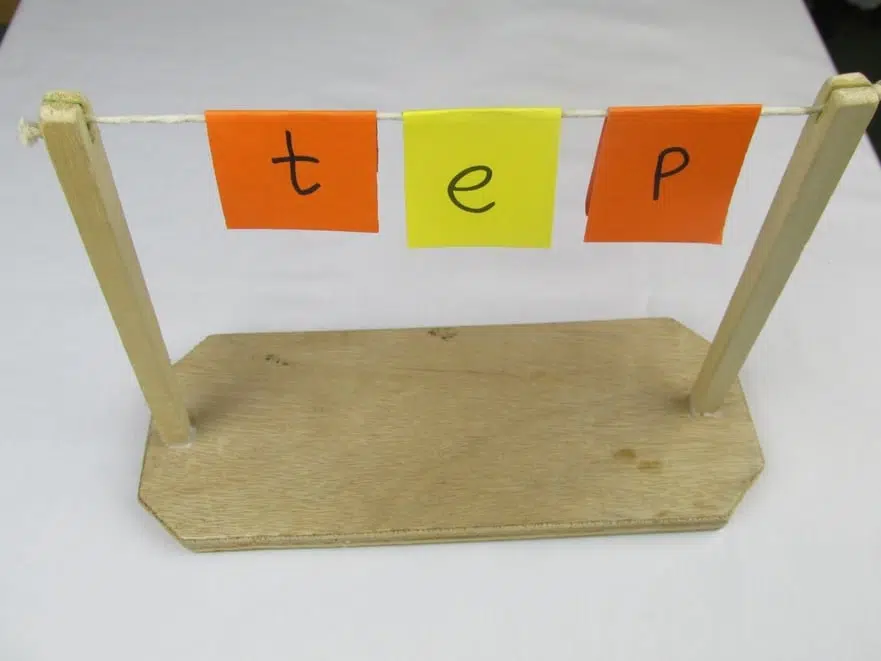
You can make big washing lines outside with just a piece of string, or you can make little mini-ones like the ones I use. If you like DIY these are simple to make, and you can use them for math, phonics, storytelling and all sorts of other activities.
6. On A Train Track
There are some children that like trains above all other things on earth! You have no doubt met them.
My son, for example, was a passionate lover of trains, though now he older he isn’t really interested in them any more at all, which I always find amusing.
The idea behind this activity is to get sections of wooden train track and simply write some sounds on. Once again color coding is good.
If you don’t want to permanently graffiti your train track, you can write the sounds on pieces of masking tape, and stick them on. Then you can simply rip them off when you’ve finished.
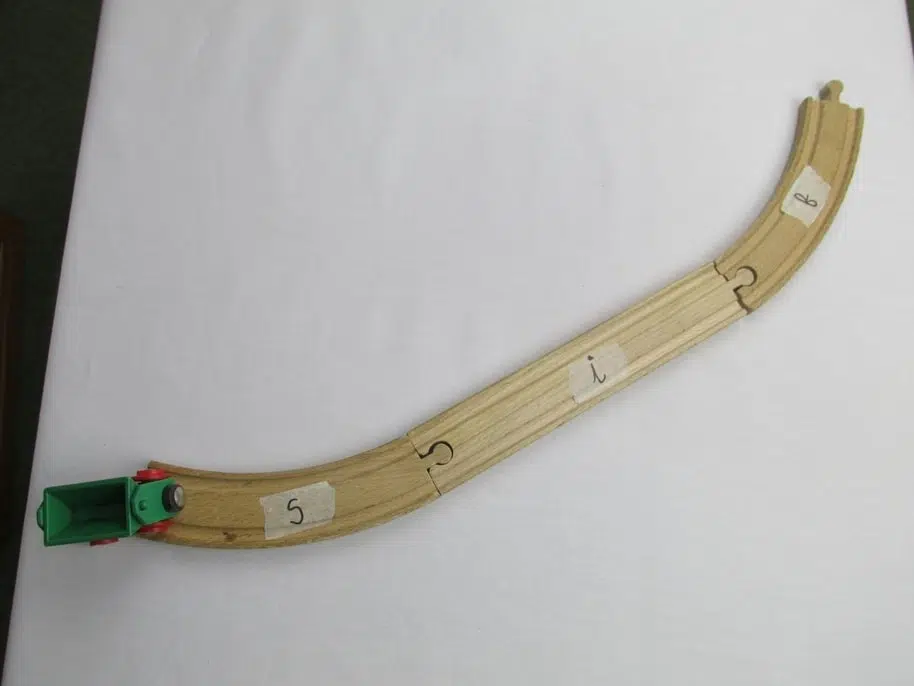
The idea is that you build a word using three pieces of track. You could have some ‘train words of the day’ that they can try to build.
Then the train goes over the sounds saying each sound as it goes.
A great way to get children that are simply not interested in phonics to just get started and give it a bit of a go. Trains are one of the ultimate resources for many young children! A train is needed for my favorite alliteration activity, that you can read about here in my article about the 10 best alliteration games.
7. Using Flashcards Against The Clock
Some children respond really well to timers and the challenge of beating their friends!
The idea behind this game is that you have some nonsense words written on cards. You also have a sand-timer – a 30 second one would work well, or some other quite short time period.
One child goes first. They have the stack of nonsense words. One other child turns over the timer, and the child starts to read. They try to read as many nonsense words as they can in 30 seconds. At the end of the time they count how many they have read.
Then the next child goes, and tries to beat that score.
They can record each other’s efforts on a big competition sheet. Normally you hope to find that the children get a bit quicker with practice.
This game is also brilliant for teaching ‘tricky’ words. Check out my twelve favorite ‘tricky’ word games here.
8. Eyeballs On Golf Tees
What child doesn’t like playing with eyeballs! Children love the gruesome nature of anything gory like this, and also love the dark comedy element.
For this activity you need some ‘eyeballs’ which could be things like golf balls painted, or polystyrene balls, or ping-pong balls.
You want to jazz up the eyeballs with pupils drawn on with permanent marker pen. Also a few blood stained lines helps the effect. Then on the other side draw some sounds.
Now you need some golf tees. You need three.
Simply stick the golf tees in anything that will hold them. For example, you could stick the tees into a sponge. Or it could be slab of plasticine.
I have drilled holes into small pieces of wood, and superglued the golf tees into it. However, this is not essential.
The idea then is to build words with the eyeballs.
You could have some ‘eyeball words’ that the children can try to copy, either real or nonsense. Then they can try to match the sounds, and begin to sound them out.
Great for fine motor, dexterity, and also an engaging phonic activity as well.

9. Sounds On Loose Parts Objects
In phonics, often the simplest ideas and resources are the best.
You don’t always need to make elaborate or expensive resources. You can write sounds on random objects that can be used in playful ways.
Good examples, are things like bottle tops, corks, stones, wood slices, and leaves. For a full list of resources check out my article about the 100 best materials for loose parts.
Have some word lists to go with the resources. For example, a list of leaves words that you can make by putting three leaves in a line.
Children like fiddling with natural objects, and experimenting.
10. Trash V Real
This is a classic game, and one that can be brought to life in a range of ways.
You have two containers – one for the nonsense words, and one for real words.
A good example is a bin for nonsense words and a treasure chest for real. I have also seen this recently on social media as an emoji game. It was a bucket with a happy emoji on for real words, and a bucket with an angry one on for nonsense. Whole words were written on balls that the children put in one of the two buckets. Pure genius!
You can write the whole words on whatever you like – big gold coins, shells, stones, polystyrene eggs.
Then the children try to read them, and think about whether they are real or nonsense. Then they put them in the right container.
Problems You May Encounter
Some children find learning nonsense words much harder than other children.
Some issues I have found are:
- Some children tend to try to convert the nonsense words into real words. This is very understandable, as this is to some extent how we learn to read anyway. Our brain tries to make sense of sequences of letters.
- Sometimes children that have English as a foreign language have greater issues learning to read nonsense words. This is not always the case, but where this is happening, it is usually for the same reason that they are trying to make a real word out of the nonsense word.
- Some children with conditions like autism may sometimes have issues deciphering the real or nonsense aspect of a word
- Children with a limited vocabulary will not know often if a word is real or silly.
What’s The Answer?
Keep practicing! Nonsense words should not be the be all and end all of learning phonics. Many children learn to read brilliantly without fully grasping this concept.
The emphasis should always be more on teaching real words. Teaching nonsense words should just be an enhancement to what you are doing.
Conclusion
Good luck trying out these nonsense words ideas.
Teaching nonsense words should be good fun. It has a playful side which children find appealing. They also often find them funny.
Exciting resources can bring the process to life, and you will hopefully find benefits in teaching them that will come out in many ways in the future.
If you’ve found this article useful then why not check out one of these:
